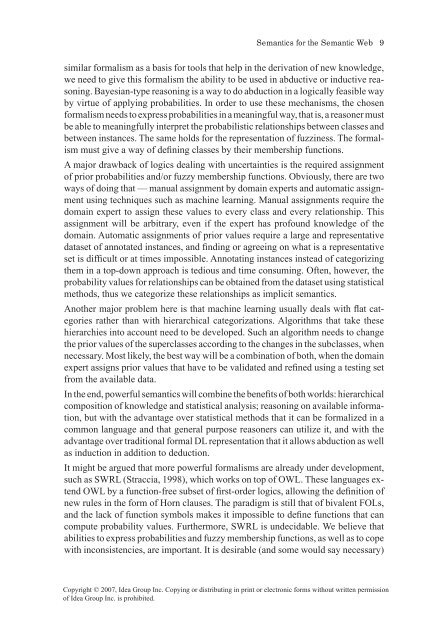Semantic Web-Based Information Systems: State-of-the-Art ...
Semantic Web-Based Information Systems: State-of-the-Art ...
Semantic Web-Based Information Systems: State-of-the-Art ...
You also want an ePaper? Increase the reach of your titles
YUMPU automatically turns print PDFs into web optimized ePapers that Google loves.
Semant cs for <strong>the</strong> Semant c <strong>Web</strong><br />
similar formalism as a basis for tools that help in <strong>the</strong> derivation <strong>of</strong> new knowledge,<br />
we need to give this formalism <strong>the</strong> ability to be used in abductive or inductive reasoning.<br />
Bayesian-type reasoning is a way to do abduction in a logically feasible way<br />
by virtue <strong>of</strong> applying probabilities. In order to use <strong>the</strong>se mechanisms, <strong>the</strong> chosen<br />
formalism needs to express probabilities in a meaningful way, that is, a reasoner must<br />
be able to meaningfully interpret <strong>the</strong> probabilistic relationships between classes and<br />
between instances. The same holds for <strong>the</strong> representation <strong>of</strong> fuzziness. The formalism<br />
must give a way <strong>of</strong> defining classes by <strong>the</strong>ir membership functions.<br />
A major drawback <strong>of</strong> logics dealing with uncertainties is <strong>the</strong> required assignment<br />
<strong>of</strong> prior probabilities and/or fuzzy membership functions. Obviously, <strong>the</strong>re are two<br />
ways <strong>of</strong> doing that — manual assignment by domain experts and automatic assignment<br />
using techniques such as machine learning. Manual assignments require <strong>the</strong><br />
domain expert to assign <strong>the</strong>se values to every class and every relationship. This<br />
assignment will be arbitrary, even if <strong>the</strong> expert has pr<strong>of</strong>ound knowledge <strong>of</strong> <strong>the</strong><br />
domain. Automatic assignments <strong>of</strong> prior values require a large and representative<br />
dataset <strong>of</strong> annotated instances, and finding or agreeing on what is a representative<br />
set is difficult or at times impossible. Annotating instances instead <strong>of</strong> categorizing<br />
<strong>the</strong>m in a top-down approach is tedious and time consuming. Often, however, <strong>the</strong><br />
probability values for relationships can be obtained from <strong>the</strong> dataset using statistical<br />
methods, thus we categorize <strong>the</strong>se relationships as implicit semantics.<br />
Ano<strong>the</strong>r major problem here is that machine learning usually deals with flat categories<br />
ra<strong>the</strong>r than with hierarchical categorizations. Algorithms that take <strong>the</strong>se<br />
hierarchies into account need to be developed. Such an algorithm needs to change<br />
<strong>the</strong> prior values <strong>of</strong> <strong>the</strong> superclasses according to <strong>the</strong> changes in <strong>the</strong> subclasses, when<br />
necessary. Most likely, <strong>the</strong> best way will be a combination <strong>of</strong> both, when <strong>the</strong> domain<br />
expert assigns prior values that have to be validated and refined using a testing set<br />
from <strong>the</strong> available data.<br />
In <strong>the</strong> end, powerful semantics will combine <strong>the</strong> benefits <strong>of</strong> both worlds: hierarchical<br />
composition <strong>of</strong> knowledge and statistical analysis; reasoning on available information,<br />
but with <strong>the</strong> advantage over statistical methods that it can be formalized in a<br />
common language and that general purpose reasoners can utilize it, and with <strong>the</strong><br />
advantage over traditional formal DL representation that it allows abduction as well<br />
as induction in addition to deduction.<br />
It might be argued that more powerful formalisms are already under development,<br />
such as SWRL (Straccia, 1998), which works on top <strong>of</strong> OWL. These languages extend<br />
OWL by a function-free subset <strong>of</strong> first-order logics, allowing <strong>the</strong> definition <strong>of</strong><br />
new rules in <strong>the</strong> form <strong>of</strong> Horn clauses. The paradigm is still that <strong>of</strong> bivalent FOLs,<br />
and <strong>the</strong> lack <strong>of</strong> function symbols makes it impossible to define functions that can<br />
compute probability values. Fur<strong>the</strong>rmore, SWRL is undecidable. We believe that<br />
abilities to express probabilities and fuzzy membership functions, as well as to cope<br />
with inconsistencies, are important. It is desirable (and some would say necessary)<br />
Copyright © 2007, Idea Group Inc. Copying or distributing in print or electronic forms without written permission<br />
<strong>of</strong> Idea Group Inc. is prohibited.


